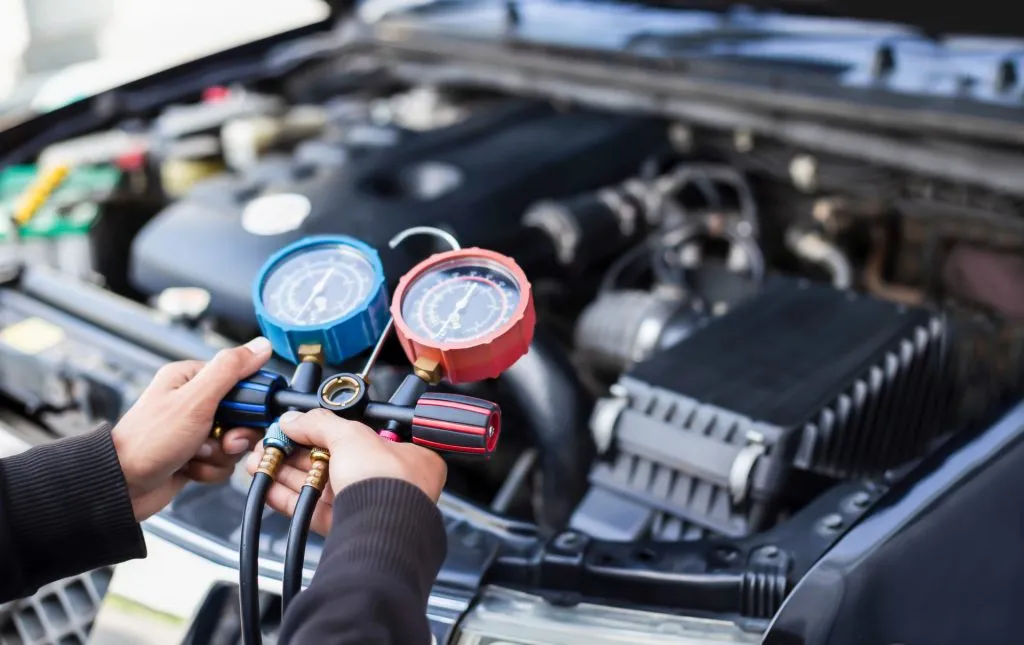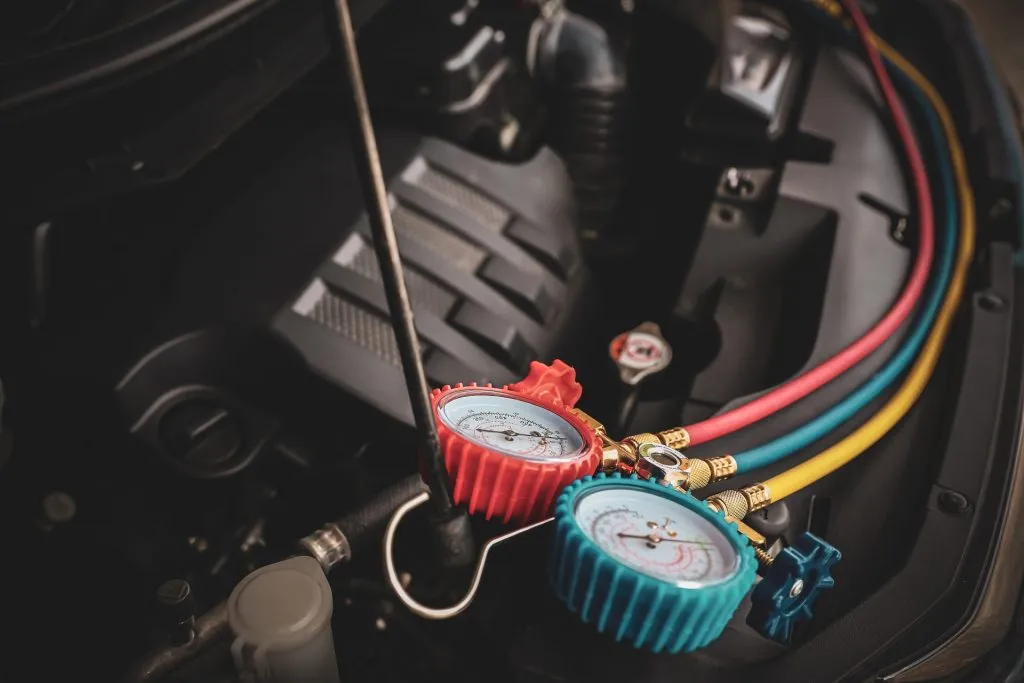Car AC Troubleshooting: Why Isn’t Your AC Blowing Cold Air?
Summer season has arrived, and you need an operational car air conditioning (AC) system to relish your long road trip. Drivers are usually frustrated when their car AC is not cooling. In such cases, it is necessary to diagnose and have your car cooling system working as quickly as possible. To do this, you have to understand the probable causes why it is not blowing cold air. In this article, we will talk about the probable cause of a malfunctioning AC, low refrigerant level check, and repair techniques in preventing future malfunctions.

What Are the Common Reasons for Car AC Not Blowing Cold Air?
Understanding Low Refrigerant Levels
Low refrigerant is also one of the most common answers to the question «Why is the car AC not cooling but the fan is running?» Refrigerant is the fluid that causes cool air to be generated in your vehicle, and when it is low, the AC system will not work as usual – a problem that often requires car AC repair. Low refrigerant can be caused by a variety of reasons including normal evaporation over time or system leakage.
Identifying a Refrigerant Leak
Leakage of refrigerant will substantially impact your AC performance. Leaks are characterized by hissing, oil drops observed around the AC components, or reduced cooling capacity. Once there is any single sign of leakage, it is crucial to have it repaired and serviced professionally because the refrigerant is an environmental pollutant and has to be disposed of properly.
Common Causes of AC Compressor Failure
AC compressor is the hub of air conditioning and is present to be a system of transferring the refrigerant. Failure of the compressor can be caused by many reasons, some of which include electricity, improper lubrication, or failing due to old age. If you have a faulty compressor, the AC will never give cold air, and you will probably hear strange noises and smell smoky odors.

How to Check the Refrigerant Levels in Your Car AC?
Tools Needed to Check Refrigerant Levels
In order to test the levels of refrigerant in your car’s AC system, you will need to have some equipment available, some of which is:
- A set of refrigerant gauges
- Safety glasses and gloves
- A refrigerant can if topping off is required
Steps to Properly Check Refrigerant in Your AC
- Locate the Low-Pressure Service Port (Plug): Usually on the big aluminum tube.
- Install the Refrigerant Gauge: Place the blue gauge in the low-pressure port.
- Check Out the Pressure: Drive the car and operate AC to full. Inspect the gauge. If the level is lower than the standard, it indicates low refrigerant.
- Unscrew the Gauge: Unscrew the gauge and hand tighten the service port cover.
Signs Your AC May Need a Recharge
If your AC blower is producing air that is warm, or if airflow is reduced, then the system needs to be recharged. Any one of the following are signs to look out for: ice on the components of the AC or an abnormal rise in the humidity level in the vehicle.

What to Do If Your Car AC Is Blowing Hot Air?
Diagnosing the AC System Components
If your car air conditioning is blowing hot air, begin by examining the components of the system for malfunctioning. Examine the compressor, the condenser, and the expansion valve to make sure they are functioning properly. Inspect the pump for unusual noises and check for damage.
Checking the Compressor Clutch Operation
The AC system needs the compressor clutch to turn on and off. If the clutch is not engaging, it may indicate an electrical issue or a problem with the compressor itself. Clutch operation can be verified by examination of the clutch while the AC is running.
Assessing the Cabin Air Filter Condition
A clogged cabin air filter can limit airflow and lead to low cooling. Get your cabin air filter checked and replaced when necessary for best performance. Dirty cabin air filters may produce odors in the car.
How to Troubleshoot a Malfunctioning Compressor?
Identifying Signs of a Faulty Compressor
Signs of a failing compressor are odd noises, an odor, or AC blowing warm air in event the thermostat is low. In the event that you think the issue is compressor-related, call an expert.
Testing the Compressor Clutch
To check the clutch in the compressor, attempt an electrical continuity test with a multimeter. If no continuity exists, the clutch will have to be replaced. Also, listen for any clicking when AC is on; it might be a sign that the clutch is not functioning correctly.
When to Replace the AC Compressor
If your compressor is not operational, then the time to change it has come. Changing the compressor is an expensive proposition, so ensure everything else is in top condition in order to simplify things down the line.
Can a Clogged Condenser Affect AC Performance?
Understanding the Role of the Condenser
The condenser also cools the refrigerant before it gets into the evaporator. Air flow in the condenser should be maintained free of obstruction. The condenser should be cleaned at intervals in an attempt to maintain it in its best condition.
How to Check for Clogs in the Condenser
Clean the dirt, grime, or damage from the condenser with a brush or compressed air. Ensure that the fins are not bent or blocked and may breathe.
Cleaning the Condenser for Improved Airflow
To clean the condenser correctly, do the following:
- Turn the Engine Off: Switch off the car and let it cool.
- Clear the Debris: Clear loose debris from the surface of the condenser using a vacuum cleaner or a soft-bristled brush.
- Do the Water Washing (Flushing): Water wash during the dirt buildup on the condenser. Don’t use high-pressure water, as that will ruin the fins.
- Straighten the Fins: To straighten crooked fins, carefully straighten them using a fin comb or some similar tool to restore air flow.
- Recheck the Airflow: Run the engine after cleaning and see if the AC function is better.

What Maintenance Can Help Prevent AC Issues?
Regularly Checking and Replacing the Cabin Air Filter
One of the easiest service methods that can be applied to your AC system is to check and replace the cabin air filter at regular intervals. A new filter provides maximum airflow and keeps dirt from entering the AC system. Replace the filter every 12,000 to 15,000 miles or as indicated in your owner’s manual, or book a car service in Dubai to have it done professionally.
Importance of Routine AC System Inspections
Regular servicing of the AC system may assist in ensuring that any issue is resolved prior to it becoming major trouble. Get a competent technician to check the amount of refrigerant, the operation of the compressor, and system performance at least annually, or upon the beginning of hot weather.
Keeping an Eye on the Cooling Fan Functionality
The cooling fan is also part of the AC system since it helps to dissipate heat from the condenser. Check if the cooling fan operates by listening for it when operating the AC. If the fan is not rotating, replace or fix it to enable the AC to operate normally.
Knowing the answers to the most frequent answers to such questions as «Why is my car AC not cooling while idling?», «Why is my car AC not cooling sometimes?» or «Why doesn’t my car AC blow cold air?», and by following the above step-by-step troubleshooting, you can fix the faults in the correct way before they grow into more serious faults. Regular checkup and early repair will not only give you a hassle-free drive but also extend the life of your car air conditioner. In case you are not sure what to do, never hesitate to reach out to a professional expert.




